Planting a tree correctly is essential for its health and longevity!
Do you want to know how to properly plant a tree? Maybe you are planting a tree for the first time or you want to know the best practices for ensuring your tree grows healthy and strong. Planting a tree correctly can be tricky, as there are many important steps involved. It can be hard to know where to start, but understanding the basics of proper tree planting is key. In this article, we will provide tips on how to properly plant a tree so that it has the best chance of survival and growth. We will cover topics such as choosing the right spot, what type of soil is best for planting, and how to water your newly planted tree.
With this information in hand, you’ll be equipped with the knowledge necessary to give your new tree the best start possible!Choosing the right tree species is an important decision, as certain trees require specific growing conditions and may not thrive in your area. To ensure you’ll have the healthiest and most beautiful tree, research the different types of trees that grow in your region, as well as their individual characteristics and needs. Once you’ve narrowed down your options, consider factors such as how much space you have available and what purpose the tree will serve (shade, privacy, fruit production, etc.).
Location Of Planting
Choosing the right location for planting is an important factor to consider when growing a garden. The location chosen should have good access to sunlight, water and other necessary resources. It is also important to choose a spot that is not prone to flooding or other natural disasters that could cause damage to plants. When picking a site, it is important to make sure that it has adequate drainage and soil quality, as this can greatly impact the success of the garden. Additionally, the area should be free from any potential sources of pollution or contamination from nearby sources.
Once the location has been chosen, it is also important to consider how the different plants in the garden will interact with each other. Different plants require different levels of sunlight and water, so it is important to select species that are compatible with each other for best results. Additionally, spacing out plants properly will help ensure that they are not competing for resources such as sunlight and water. Finally, it is also beneficial to include companion planting in the garden; this helps improve soil fertility and can even help ward off certain pests.
Prepare The Soil
Preparing the soil for your garden is essential if you want to grow healthy plants. The right soil mix can provide the nutrients your plants need to thrive. In order to prepare the soil, you will need to determine what type of soil you have and what nutrients it needs. You will also need to test the pH levels of your soil and make adjustments as needed.
The first step in preparing the soil is to remove any debris, such as rocks or sticks, that may be present. This will help create a more even bed for planting. Once all debris has been removed, loosen the soil by tilling or digging. This will help aerate the soil, making it easier for roots to penetrate and access water and nutrients.
Next, consider adding organic matter such as compost or manure to help improve texture and increase nutrient content. If needed, you can also add amendments such as lime or sulfur to adjust the pH level of your soil. It’s important to test your soil before making these adjustments so that you know exactly what adjustments need to be made in order to create an ideal environment for your plants.
Finally, ensure that your soil is well-drained by checking for any areas where water may pool after a heavy rainstorm or irrigation session. If needed, add drainage materials such as gravel or sand to help improve drainage and reduce standing water in the garden bed.
Once all of these steps have been taken, it’s time to plant! Your plants will now have an ideal environment in which they can grow and thrive!
Why to Dig A Hole?
Digging a hole is one of the most basic tasks in any construction or landscaping project. It is also a great way to get a better understanding of the soil and environment around you. Digging a hole can be a great way to build strength, endurance, and coordination while giving you the opportunity to explore the natural world around you. From providing a place for planting trees and plants, creating composting areas, or just giving you an understanding of the land beneath your feet, digging a hole can be an integral part of any project.
Benefits Of Digging A Hole
Digging a hole is a great way to gain an appreciation for the environment and how it works. You can see firsthand how different layers of soil interact with each other and how different types of soil can affect what grows in them. It’s also an excellent way to gain strength and flexibility as you dig deeper into the earth. And when all is said and done, you will have created something that is both practical and aesthetically pleasing.
What To Consider When Digging A Hole
When it comes to digging holes there are certain things to consider before starting your project. Depending on what type of project you are doing, it’s important to determine how deep or wide you need your hole to be as well as where the best spot for it would be located. Additionally, make sure that the area around your hole has been cleared away from debris prior to digging so that nothing gets in the way of your progress.
Using The Right Tools For The Job
Using quality tools is also essential when it comes to digging holes. Investing in quality shovels, rakes, hoes, picks, or trowels will help ensure that your projects go smoothly without having any issues along the way. Additionally, make sure that all tools are sharpened properly so they cut through dirt more easily which will save time and energy during your projects.
With these tips in mind, anyone can start their own dig-it-yourself projects with confidence knowing that they have taken all necessary precautions before beginning their work!
Placing The Tree In The Hole
Placing a tree in a hole correctly is an important part of planting trees. When planting a tree, the hole should be at least twice as wide as the root ball and about one foot deeper. It is also important to loosen the soil at the bottom of the hole to create better drainage and increase air circulation. After placing the tree in the hole, gently fill in any air spaces with soil and firm it down until it is level with the surrounding ground. To ensure that water is retained, it is important to add mulch around the base of the tree. This will also help to keep weeds away from your tree’s roots. Finally, make sure to water your tree regularly until it becomes established.
When planting a new tree, you should always take your time when digging and filling in the hole so that you make sure that everything is done properly. Doing this will help ensure that your new tree has a strong root system and will thrive for many years.

Dig the Hole
Digging a hole is a necessary step when planting a tree or shrub. It is important to determine the size of the hole necessary for the particular type of tree or shrub you are planting. Generally, it should be two to three times wider than the root ball of the tree or shrub. Dig out any grass, roots and other debris from the bottom of the hole. Make sure that the sides and bottom are smooth, so that it will be easy for water to flow through.
Add Soil Amendments
Once you have finished digging the hole, it is important to add soil amendments such as compost and manure. These amendments will help improve drainage and provide nutrients for your newly planted tree or shrub. These amendments should be mixed into the soil at a ratio of one part amendment to three parts native soil. If you are planting a large tree, such as an oak, consider adding peat moss or shredded bark mulch for additional drainage.
Place Plant in Hole
Once you have added your soil amendments and mixed them into your native soil, it’s time to place your plant in the hole. Carefully place your plant in the center of the hole so that its root ball is level with ground level around it. Make sure not to bury too deep as this can cause water to pool around its root system and cause rot or disease.
Fill With Soil & Water
Once your plant is placed in the hole, fill it with soil that you have prepared beforehand. Tamp down on each side of your plant as you fill with soil so that there are no air pockets which can cause drying out and dehydration of your newly planted tree or shrub. Once finished, water thoroughly until there is a small puddle at ground level around your new plant.
Backfill The Hole With Soil
Once all of the excess water has drained away, lightly backfill any remaining areas with more of your prepared soil mix until level with surrounding ground cover. Finish by mulching around your new plant to help retain moisture in its root system and provide protection from weeds or pests.
Water The Tree Properly
Watering a tree is an important part of tree care. It helps the tree to stay healthy and promote its growth. Proper watering of a tree can help it reach its full potential. However, it is important to understand that there are certain rules that need to be followed when it comes to watering a tree.
First and foremost, you need to make sure that you are providing the right amount of water for the particular type of tree you have. Different trees have different requirements when it comes to water, so you should research the particular species before attempting to water it. Additionally, if your area has experienced a period of drought or has low soil moisture content, then you may need to water more frequently.
When watering a tree, always remember that slow and deep is much better than shallow and frequent. To ensure that your tree gets enough moisture, try using a soaker hose or drip irrigation system instead of simply pouring water onto the soil around the base of the tree. This will help ensure that all parts of the root system get an even distribution of moisture without over-watering some areas while leaving others dry.
You should also be mindful of how much water you use when watering your tree as too much can be detrimental to its health. Try not to use more than an inch or two per week during periods where there is no rainfall in order to avoid overwatering your tree and creating standing pools of water around its roots which can become breeding grounds for pests and diseases.
Overall, proper watering is essential for any type of plant but especially for trees as they are larger and require more resources in order for them to stay healthy and thrive in their environment. Make sure you are providing enough but not too much water according to their needs in order for them to reach their full potential!
Significantly Prune Newly Planted Trees
Pruning newly planted trees is an important part of maintaining healthy, vigorous growth and structure. It helps establish a strong branch structure, remove any dead or diseased branches, and reduce the size of the tree when necessary. Pruning should be done soon after planting and then again during the first growing season. This will help ensure that the tree is growing in the right direction, with a strong branch structure. Pruning can significantly reduce the size of a newly planted tree if needed, but it should be done carefully to avoid damaging the tree’s delicate new growth.
When pruning newly planted trees, it is important to remember that pruning should not be too drastic or aggressive. If possible, only remove about one-third of each branch at a time and avoid removing more than one-third of the total canopy for any given tree. It is also important to use sharp pruning tools so that cuts are clean and not jagged or uneven. This will help prevent wounding and disease from entering through open wounds in branches.
When pruning newly planted trees, it is also important to consider how much sunlight they will receive after pruning has taken place. If too much sunlight is allowed in through pruned branches, this can cause sunburn or heat damage on tender new growth when temperatures are high during summer months. Additionally, if large branches are removed from a young tree it can cause shock to the system and slow down its growth significantly.
In summary, if properly done, pruning can significantly reduce the size of newly planted trees when needed. However, it should be done carefully to avoid causing too much shock or damage to immature branches and foliage. Pruning tools should always be kept sharp so that cuts are clean and even with minimal wounding risk and consideration should be made for how much sunlight will reach young foliage after pruning has been completed.

Conclusion
Planting a tree is an important part of preserving the environment. It can bring life to a barren environment and provide necessary oxygen for us to breathe. Trees also help prevent soil erosion and promote biodiversity. By following these steps, you can ensure that your tree will have the best chance of growing strong and healthy.
The most important step in planting a tree is to prepare the ground properly. Start by digging a hole that’s twice as wide as the root ball and just as deep. Add some organic matter to the soil to improve its drainage. Place the tree in the hole and add back some of the original soil around it before backfilling with additional soil. Make sure that you water your newly planted tree regularly and mulch it to help protect its roots from extreme temperatures and moisture loss.
Tree planting is an act of conservation that can be rewarding no matter how small or big your project is. With proper care, your efforts will be rewarded with a beautiful addition to your landscape for years to come.
Thank you for taking the time to learn about how to properly plant a tree!

My interest in trees started when I first saw the giant sequoias in Yosemite.
I was a teenager then, and I remember thinking, “I need to learn more about this.”
That moment stuck with me.
A few years later, I went on to study forestry at Michigan Tech.
Since graduating, I’ve worked in a mix of hands-on tree care and community education.
I’ve spent over ten years helping people understand how to plant, maintain, and protect the trees in their neighborhoods.
I don’t see trees as just part of the landscape.
They are living things that make a real difference in our daily lives.
